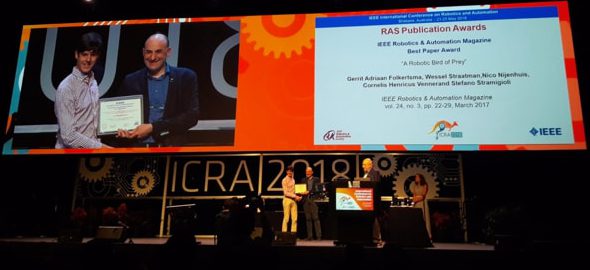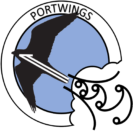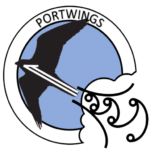Description
What is Portwings?
PortWings is a ERC 2018 Advanced Grant (Ad.G) of 2.8M Euros awarded to Prof. Stefano Stramigioli, which will officially started on 1-10-2018 and will last 5 years totally. An ERC Ad.G. is the most prestigious grant financed by the Horizon 2020 of the European Commission within the European Research Council.
Scope of the Project
Flapping flight is one of the wonders of nature and has been vastly studied by biologists and fluid dynamicists. Many artifacts that mimic biological systems have been built at different scales. For example, based on the pioneering experimental trial and error work of some falconers and model builders, we have contributed to improve a system that resembles the steady flapping behaviour of its biological counterpart and can fly untethered, stably up to 80 km/h in up to 5 Beaufort wind speed and switch between flapping and gliding. This is the Robird developed in cooperation with the University of Twente, which got the 2016 ERF Tech Transfer Award to the spin-off Clear Flight Solutions, and it is commercially now exploited by Aerium Analytics in Canada.
The PI and co-authors also received the IEEE Robotics and Automation Magazine Best Paper Award with the paper titled “Robird: A Robotic Bird of Prey” delivered at the IEEE Robotics and Automation Conference in Brisbane, Australia. Even if this technology and results are unique and recognised worldwide, we still do not fully understand flapping flight to the scientific depth needed to go even further: the original makers of the Robird managed to get this device flying thanks to good insights and trial and errors, but the real physics has not yet been clarified and to change this is the main goal of the project.

The Robird cannot take off on its own, cannot perch, uses symmetric flapping, steers using a number of manifolds placed on the tail and has a minimal autonomy and a restricted operation time due to power consumption. In PortWings we will gain a much deeper structured understanding of flapping flight and experimentally validate these understandings. This will be done using port-Hamiltonian (PH) system theory and its physically unifying character, which will couple fluid dynamics theory to dynamically changing surfaces and their actuation. The framework has proven to have unique features in connecting distributed and lumped parameters systems of different domains at different scales. This framework allows to study in a unified way the actuation achieving mechanical deformations of the wings and its interaction with the flow.
Our Goals
We want to go further than ever before, by modelling and understanding the generation of vortices by mechanical deformations of surfaces and volumes of the wings and body of birds and then understand how to control it. After validating the models by wind tunnel tests with flow visualisation, numerical optimisation will be used to fine tune models and search for uncertain parameters. Based on these findings, artefacts will be built to validate the generated models with real systems. Last but not least, based on the insight gained, a new robotic bird will be realised with unprecedented flight dexterity, able to flap asymmetrically, adapt to the flow and take off and land as birds do, in order to validate the scientific understandings.

